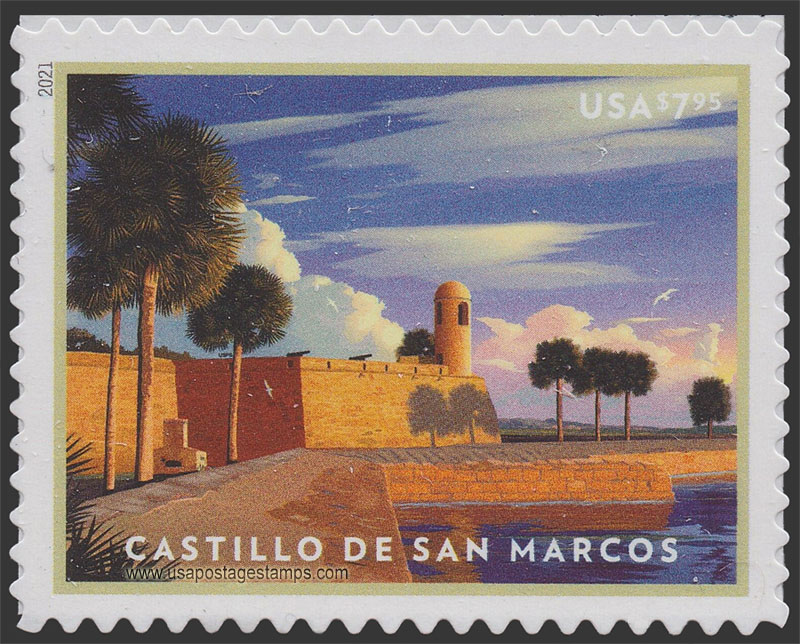US 2021 Castillo de San Marcos, St. Augustine, FL $7.95 Scott. 5554

Series: American Landmarks Expedited Service Rate Series
Stamp details: Castillo de San Marcos, St. Augustine, Florida
Issued date: 24-01-2021 (dd/mm/yyyy)
Face value: $7.95
Format: Pane of 4
Emission: Definitive (Priority Mail)
First Day City: St. Augustine, Florida
Catalogue No:-
Scott (USA): 5554
Michel (Germany): 5787
Yvert et Tellier (France): 5396
Unificato (Italy): 5946
Designers: Greg Breeding (designer) ; Dan Cosgrove (artist)
Dimensions (height x width):
31.25mm x 39.75mm
Printer: Ashton Potter (USA) Ltd.
Print Method: Offset, Microprint
Perforation: Serpentine Die Cut 10¾ x 10½
Stamp Colors: Multicolored
Gum type: Self-Adhesive
Themes: Fort, Trees, Pond, Bird
Total print: 5,500,000 (estimate)
Stamp details: Castillo de San Marcos, St. Augustine, Florida
Issued date: 24-01-2021 (dd/mm/yyyy)
Face value: $7.95
Format: Pane of 4
Emission: Definitive (Priority Mail)
First Day City: St. Augustine, Florida
Catalogue No:-
Scott (USA): 5554
Michel (Germany): 5787
Yvert et Tellier (France): 5396
Unificato (Italy): 5946
Designers: Greg Breeding (designer) ; Dan Cosgrove (artist)
Dimensions (height x width):
31.25mm x 39.75mm
Printer: Ashton Potter (USA) Ltd.
Print Method: Offset, Microprint
Perforation: Serpentine Die Cut 10¾ x 10½
Stamp Colors: Multicolored
Gum type: Self-Adhesive
Themes: Fort, Trees, Pond, Bird
Total print: 5,500,000 (estimate)
Description:- The Castillo de San Marcos is the oldest masonry fort in the continental United States; it is located on the western shore of Matanzas Bay in the city of St. Augustine, Florida. It was designed by the Spanish engineer Ignacio Daza, with construction beginning in 1672, 107 years after the city's founding by Spanish Admiral and conquistador Pedro Menéndez de Avilés, when Florida was part of the Spanish Empire. The fort's construction was ordered by Governor Francisco de la Guerra y de la Vega after a raid by the English privateer Robert Searles in 1668 that destroyed much of St. Augustine and damaged the existing wooden fort. Work proceeded under the administration of Guerra's successor, Manuel de Cendoya in 1671, and the first coquina stones were laid in 1672. The construction of the core of the current fortress was completed in 1695, though it would undergo many alterations and renovations over the centuries.
Source: en.wikipedia.org/wiki/Castillo_de_San_Marcos
Source: en.wikipedia.org/wiki/Castillo_de_San_Marcos




